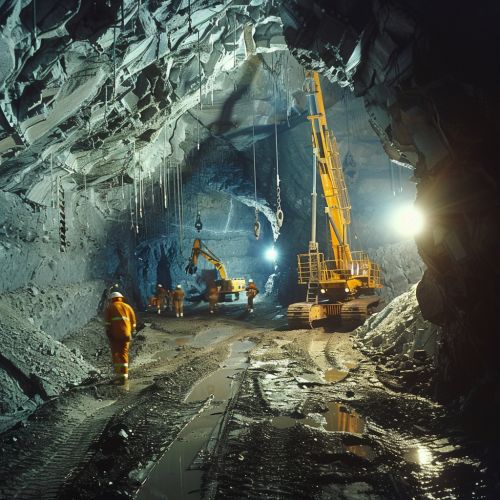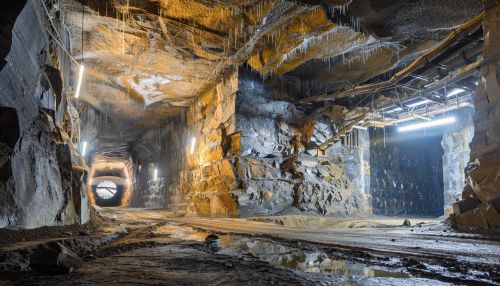Block caving
Introduction
Block caving is a highly efficient underground mining method that involves undermining an ore body, allowing it to progressively collapse under its own weight. This technique is particularly suited for the extraction of large, low-grade ore bodies, and is commonly used in the mining of copper, gold, and other base metals. The method leverages gravity to break and transport the ore, making it one of the most cost-effective and productive mining methods available.
History and Development
The origins of block caving can be traced back to the early 20th century, with significant advancements occurring throughout the decades. Initially developed in the United States for the extraction of iron ore, the method quickly gained popularity due to its economic advantages. Over time, technological advancements and improved understanding of rock mechanics have refined the technique, making it applicable to a wider range of ore bodies and geological conditions.
Principles of Block Caving
Block caving relies on the principle of induced caving, where the ore body is undercut, causing it to collapse under its own weight. This process is facilitated by the natural fractures and weaknesses within the rock mass. The key components of block caving include:
- **Undercutting**: The initial phase involves creating an undercut level beneath the ore body. This is achieved by drilling and blasting, creating a void that destabilizes the ore above.
- **Drawpoints**: These are strategically placed openings through which the broken ore is extracted. The placement and design of drawpoints are critical for efficient ore recovery.
- **Gravity Flow**: Once the ore body is undercut, gravity causes the fractured rock to cave and flow towards the drawpoints. This natural movement is harnessed to transport the ore to the surface.
Geomechanics and Rock Behavior
Understanding the geomechanical properties of the ore body and surrounding rock is crucial for successful block caving operations. Factors such as rock strength, fracture density, and stress distribution influence the caving process. Advanced modeling techniques, including numerical simulations and physical modeling, are used to predict rock behavior and optimize the caving sequence.
Operational Considerations
Block caving operations require meticulous planning and execution. Key considerations include:
- **Ore Body Geometry**: The shape, size, and orientation of the ore body influence the design of the undercut and drawpoints.
- **Fragmentation**: The size and distribution of broken rock fragments affect ore flow and recovery rates. Controlled blasting techniques are employed to achieve optimal fragmentation.
- **Subsidence Management**: The collapse of the ore body can cause surface subsidence, impacting infrastructure and the environment. Monitoring and mitigation strategies are essential to manage these effects.
Equipment and Technology
Modern block caving operations utilize a range of specialized equipment and technologies to enhance efficiency and safety. These include:
- **Load-Haul-Dump (LHD) Machines**: These vehicles are used to transport broken ore from the drawpoints to the crushers or conveyors.
- **Automated Systems**: Automation and remote control technologies improve precision and reduce the need for human presence in hazardous areas.
- **Monitoring Systems**: Advanced monitoring tools, such as seismic sensors and ground-penetrating radar, provide real-time data on rock movement and stability.
Environmental and Safety Considerations
Block caving has several environmental and safety implications that must be addressed. These include:
- **Dust and Noise Control**: Measures are implemented to minimize dust and noise emissions, protecting workers and surrounding communities.
- **Groundwater Management**: The presence of groundwater can affect caving operations and stability. Dewatering systems are used to manage water inflows.
- **Worker Safety**: Ensuring the safety of workers is paramount. This involves rigorous training, adherence to safety protocols, and the use of personal protective equipment (PPE).
Case Studies
Several notable block caving operations around the world demonstrate the effectiveness and versatility of this mining method. Examples include:
- **El Teniente Mine (Chile)**: One of the largest underground copper mines globally, utilizing block caving to extract vast quantities of ore efficiently.
- **Northparkes Mine (Australia)**: Known for its innovative use of automated systems in block caving operations.
- **Palabora Mine (South Africa)**: A significant producer of copper, employing block caving to access deep ore reserves.
Future Trends and Innovations
The future of block caving is marked by ongoing innovations aimed at improving efficiency, safety, and environmental sustainability. Key trends include:
- **Digitalization**: The integration of digital technologies, such as the Internet of Things (IoT) and artificial intelligence (AI), to enhance real-time monitoring and decision-making.
- **Sustainable Practices**: Efforts to minimize the environmental footprint of block caving through sustainable mining practices and rehabilitation programs.
- **Advanced Geomechanical Modeling**: Continued advancements in geomechanical modeling techniques to better predict rock behavior and optimize caving strategies.
See Also
References


